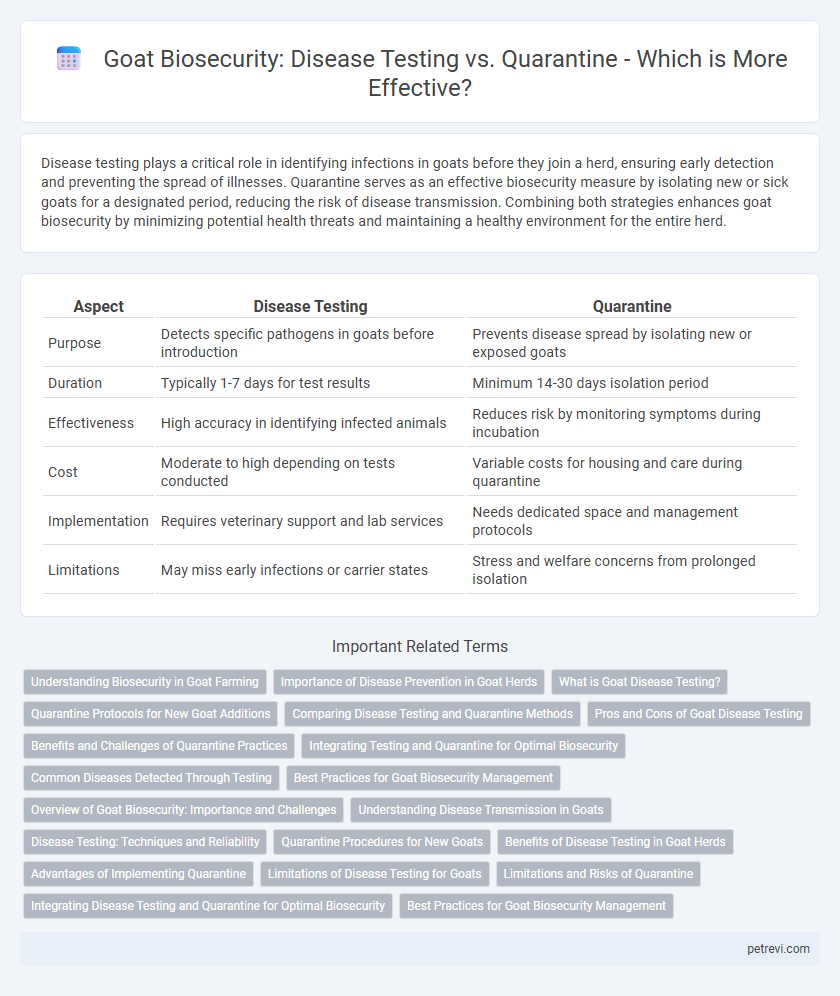Disease testing plays a critical role in identifying infections in goats before they join a herd, ensuring early detection and preventing the spread of illnesses. Quarantine serves as an effective biosecurity measure by isolating new or sick goats for a designated period, reducing the risk of disease transmission. Combining both strategies enhances goat biosecurity by minimizing potential health threats and maintaining a healthy environment for the entire herd.
Table of Comparison
| Aspect | Disease Testing | Quarantine |
|---|---|---|
| Purpose | Detects specific pathogens in goats before introduction | Prevents disease spread by isolating new or exposed goats |
| Duration | Typically 1-7 days for test results | Minimum 14-30 days isolation period |
| Effectiveness | High accuracy in identifying infected animals | Reduces risk by monitoring symptoms during incubation |
| Cost | Moderate to high depending on tests conducted | Variable costs for housing and care during quarantine |
| Implementation | Requires veterinary support and lab services | Needs dedicated space and management protocols |
| Limitations | May miss early infections or carrier states | Stress and welfare concerns from prolonged isolation |
Understanding Biosecurity in Goat Farming
Disease testing in goat farming is essential for early detection of pathogens such as Caprine Arthritis Encephalitis Virus (CAEV) and Johne's disease, enabling targeted interventions to prevent outbreaks. Quarantine protocols, typically lasting 30 days or more, isolate new or returning goats to monitor for signs of illness and reduce the risk of introducing infectious agents like CL (Caseous Lymphadenitis) into the herd. Effective biosecurity combines rigorous disease testing and quarantine measures to safeguard herd health, ensuring productivity and minimizing economic losses in goat farming operations.
Importance of Disease Prevention in Goat Herds
Disease testing plays a crucial role in identifying infections early and preventing the introduction of pathogens into goat herds, ensuring overall herd health. Quarantine protocols help isolate new or sick animals, reducing the risk of disease spread and maintaining a biosecure environment. Effective disease prevention strategies, combining testing and quarantine, are essential to safeguard goat productivity and minimize economic losses.
What is Goat Disease Testing?
Goat disease testing involves screening animals for specific pathogens such as Caprine Arthritis Encephalitis Virus (CAEV), Johne's disease, and Caseous Lymphadenitis to identify infections early and prevent outbreaks. Accurate diagnostic methods include serological tests, polymerase chain reaction (PCR), and culture techniques, which enable timely intervention and herd management decisions. Implementing comprehensive disease testing protocols enhances biosecurity by reducing the risk of introducing or spreading contagious diseases within goat populations.
Quarantine Protocols for New Goat Additions
Quarantine protocols for new goat additions typically involve isolating newcomers for a minimum of 21 to 30 days to monitor for signs of infectious diseases like CAE, CL, or Johne's disease. Disease testing during quarantine, including blood tests and fecal cultures, enhances early detection, preventing pathogen introduction to the herd. Maintaining strict quarantine combined with biosecurity measures such as individual housing, dedicated equipment, and daily health assessments optimizes goat herd health and minimizes outbreak risks.
Comparing Disease Testing and Quarantine Methods
Disease testing in goats enables early identification of specific pathogens such as caprine arthritis encephalitis virus (CAEV) and Johne's disease, providing targeted intervention opportunities. Quarantine methods isolate new or returning goats for a minimum of 21 to 30 days to monitor clinical symptoms, reducing the risk of introducing contagious diseases to the herd. Combining disease testing with quarantine protocols enhances biosecurity by ensuring both asymptomatic carriers and visibly ill animals are effectively managed.
Pros and Cons of Goat Disease Testing
Goat disease testing enables early detection of infections such as caseous lymphadenitis and caprine arthritis encephalitis, reducing the risk of outbreaks. While testing provides targeted results and supports informed management decisions, it can be costly and may yield false negatives or positives, which complicate biosecurity measures. In contrast, quarantine prevents potential transmission from new or symptomatic animals but requires extended isolation periods and ongoing monitoring without specific diagnostic confirmation.
Benefits and Challenges of Quarantine Practices
Quarantine practices in goat biosecurity significantly reduce the risk of introducing contagious diseases such as Caprine Arthritis Encephalitis and Johne's disease into herds by isolating new or returning animals for a designated period. Benefits include early detection of clinical signs and preventing asymptomatic carriers from infecting the main population; however, challenges involve the requirement for dedicated facilities, increased labor, and potential stress-induced health issues in quarantined goats. Implementing strict quarantine protocols alongside diagnostic testing enhances overall herd health management but demands careful planning and resource allocation for optimal effectiveness.
Integrating Testing and Quarantine for Optimal Biosecurity
Integrating disease testing and quarantine protocols significantly enhances goat biosecurity by enabling early identification and containment of infectious agents such as CAE virus and Johne's disease. Implementing a mandatory quarantine period coupled with comprehensive diagnostic screenings, including PCR and ELISA tests, minimizes the risk of introducing pathogens into the herd. This combined strategy supports maintaining herd health, optimizing disease management, and protecting economic value in goat production systems.
Common Diseases Detected Through Testing
Disease testing in goats is crucial for the early identification of common infections such as caprine arthritis encephalitis (CAE), caseous lymphadenitis (CL), and Johne's disease, which can severely impact herd health. Regular diagnostics using serological tests and PCR help detect these diseases before symptoms emerge, allowing prompt isolation and treatment. Quarantine complements testing by preventing the spread of infections from new or exposed animals, enhancing overall biosecurity on goat farms.
Best Practices for Goat Biosecurity Management
Effective goat biosecurity management prioritizes regular disease testing over prolonged quarantine to swiftly identify and control infectious agents such as Caseous Lymphadenitis and Caprine Arthritis Encephalitis. Implementing rapid diagnostic tests combined with targeted quarantine measures for positive cases reduces disease spread while minimizing stress and production losses. Integrating vaccination programs and strict hygiene protocols further fortifies herd immunity and enhances overall biosecurity efficacy.
Disease Testing vs Quarantine for Goat Biosecurity Infographic

 petrevi.com
petrevi.com